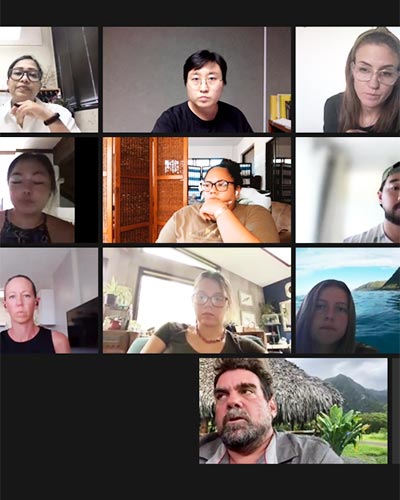Learning by doing. That is the premise of a “practicum,” in which university students transfer their academic knowledge to a project for a real-world client through research, analysis and making implementable recommendations. It’s all happening this Fall 2021, with 12 advanced-level students in the Department of Urban and Regional Planning’s (DURP) PLAN 751 class.
Their client is a 501c3 nonprofit, Ke Kula Nui o Waimānalo (KKNOW), which is dedicated to developing self-sufficiency and food sovereignty in rural windward Oʻahu. “According to KKNOW, Waimānalo has made progress in building multiple links in the food systems chain, but these efforts have often been independent of each other,” said Priyam Das, DURP associate professor and department chair. “KKNOW therefore requested a comprehensive assessment to develop an integrated, sustainable food system in the ahupua‘a of Waimānalo.”
That’s where the practicum students come in. In September they were in the midst of the stakeholder engagement phase, with the objectives of gathering and analyzing data, synthesizing relevant information – often from competing viewpoints and priorities – before presenting recommendations to KKNOW.
The DURP practicum team is being asked to engage Waimānalo organizations, groups and individual stakeholders to:
- Identify current strengths, weaknesses, opportunities and threats to a sustainable food system in Waimānalo.
- Craft near-, mid- and long-term actions to develop a sustainable food system in Waimānalo.
- Create a plan/report that may be leveraged to secure funding and other resources to implement recommendations.
The students’ enthusiasm and excitement are palpable. “Planning practicums are valuable, because we can apply the many skills that we have learned throughout the program,” said Keane Miyamoto, a second-year master’s (MURP) student. “It helps strengthen student skills that would be difficult to teach in a lecture or classroom environment, including teamwork and collaboration.” Added Sydney Kramer, also a second-year MURP student, “The planning practicum course is so valuable, because it provides the link between the schoolwork we are doing and the career we see ourselves having.”
The practicum involves more than DURP in the College of Social Sciences. KKNOW earlier partnered with the UH College of Tropical Agriculture and Human Resources to conduct a needs assessment and targeted interventions to expand the presently limited access to fresh fruits, vegetables and other local foods. And DURP is also collaborating with the UH School of Architecture for a game component, called “Just Play,” which won a national award for course development. “Four student teams will pitch their game designs to a panel of external reviewers who will select one,” said Das. “This game will then be tested, refined, and integrated into a five-week summer course for high schoolers.”
The focus of both the main project and the interactive game is food systems planning. “While the deliverable for the client project is an action plan for addressing the key issues around food systems planning in Waimānalo, the place-based educational game is a tool to create awareness about local food systems, nutrition, equity, resilience and community action,” said Das.
Ultimately, all involved in the practicum are winners. The students learn by doing, the client benefits from the team’s brainpower and ideas, and the public is ultimately strengthened. Or, as second-year MURP student Ty Shiramizu put it, “This practicum will help students grow as professionals, as well as build a framework that can be utilized and built upon for future generations.”
DURP students have won awards for their work and have presented their projects at prestigious professional events including the American Planning Association’s (APA’s) National Planning Conference, the Pacific Risk Management ‘Ohana Conference, and at meetings hosted by the APA Hawai‘i chapter. For a list of recent practicum topics, see the DURP website.
